Chapter Two
Dangerous Concept, Dangerous Times: Galileo, Kepler and the Church
Page 4I know that I am mortal by nature, and ephemeral; but when I trace at my pleasure the windings to and fro of the heavenly bodies I no longer touch the earth with my feet: I stand in the presence of Zeus himself and take my fill of ambrosia, food of the gods. — Claudius Ptolemy (c.AD 87—c.150), mathematician, astronomer, geographer, astrologer.
Introduction — Ptolemy AS the 16th century gave way to the 17th, the earth remained at the center of the known universe, the planets and sun simply revolving around it, the stars static and fixed in the heavens. This was the Ptolemaic system, also known as the Geocentric Model, and it accorded well with the church doctrine that the earth and all things were at the center of the firmament. Credit for solidifying earlier writings and concepts supporting an earth-centered universe belongs to the 2nd century A.D. astronomer Claudius Ptolemy who's astronomical book, the Almagest "was the culmination of centuries of work by Hellenic, Hellenistic and Babylonian astronomers; it was accepted for over a millennium as the correct cosmological model by European and Islamic astronomers." Shown at left is an image of Claudius Ptolemy. [1]
While the Ptolemaic system had certain observable failings that required cleverly divised solutions in order to keep it valid—sophisticated orbits outside the center of the deferent where epicycles were themselves placed on epicycles in order to explain the detailed motion of the planets on the celestial sphere—it remained the accepted science for over 1800 years. However, the system was not, as already mentioned, perfect nor was it the only theory to have been espoused or accepted. "Aristarchus of Samos was the most radical. He wrote a work, which has not survived, on heliocentrism, saying that the Sun was at the center of the universe, while the Earth and other planets revolved around it. His theory was not popular, and he had only one known follower, Seleucus of Seleucia." [2]
AS the 16th century gave way to the 17th, the earth remained at the center of the known universe, the planets and sun simply revolving around it, the stars static and fixed in the heavens. This was the Ptolemaic system, also known as the Geocentric Model, and it accorded well with the church doctrine that the earth and all things were at the center of the firmament. Credit for solidifying earlier writings and concepts supporting an earth-centered universe belongs to the 2nd century A.D. astronomer Claudius Ptolemy who's astronomical book, the Almagest "was the culmination of centuries of work by Hellenic, Hellenistic and Babylonian astronomers; it was accepted for over a millennium as the correct cosmological model by European and Islamic astronomers." Shown at left is an image of Claudius Ptolemy. [1]
While the Ptolemaic system had certain observable failings that required cleverly divised solutions in order to keep it valid—sophisticated orbits outside the center of the deferent where epicycles were themselves placed on epicycles in order to explain the detailed motion of the planets on the celestial sphere—it remained the accepted science for over 1800 years. However, the system was not, as already mentioned, perfect nor was it the only theory to have been espoused or accepted. "Aristarchus of Samos was the most radical. He wrote a work, which has not survived, on heliocentrism, saying that the Sun was at the center of the universe, while the Earth and other planets revolved around it. His theory was not popular, and he had only one known follower, Seleucus of Seleucia." [2]
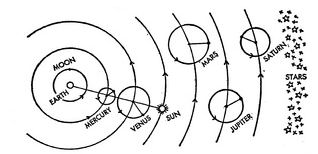 Perhaps the greatest reason for the retention of the errant geocentric model came from the unanswerable questions based on "logical reasoning" or the lack of empirical evidence which formed the basis of challenges to the theory of a sun-centered universe. If the Earth really moved around the sun, then wouldn't we see the stars move? This phenomena is called parallax and a star's parallax motion is simply a reflection of the Earth's orbital motion, but is much too small to be seen without a telescope due to the extreme distance to the stars (the first parallax would not be observed until 1837 by Friedrich Bessel using the star 61 Cygni). Yet, the seemingly inherent logic of this as well as many other questions, were used to disprove the theory of a sun-centered solar system. At right is an illustration of the Ptolemaic Universe, showing the secondary motion (epicycles) of the planets.
Perhaps the greatest reason for the retention of the errant geocentric model came from the unanswerable questions based on "logical reasoning" or the lack of empirical evidence which formed the basis of challenges to the theory of a sun-centered universe. If the Earth really moved around the sun, then wouldn't we see the stars move? This phenomena is called parallax and a star's parallax motion is simply a reflection of the Earth's orbital motion, but is much too small to be seen without a telescope due to the extreme distance to the stars (the first parallax would not be observed until 1837 by Friedrich Bessel using the star 61 Cygni). Yet, the seemingly inherent logic of this as well as many other questions, were used to disprove the theory of a sun-centered solar system. At right is an illustration of the Ptolemaic Universe, showing the secondary motion (epicycles) of the planets. -fn1
By the Middle Ages, such ideas took on a new power as the philosophy of Aristotle (newly rediscovered in Europe) was wedded to Medieval theology in the great synthesis of Christianity and Reason undertaken by philsopher-theologians such as Thomas Aquinas. The Prime Mover of Aristotle's universe became the God of Christian theology, the outermost sphere of the Prime Mover became identified with the Christian Heaven, and the position of the Earth at the center of it all was understood in terms of the concern that the Christian God had for the affairs of mankind.
Thus, the ideas largely originating with pagan Greek philosophers were baptized into the Catholic church and eventually assumed the power of religious dogma: to challenge this view of the Universe was not merely a scientific issue; it became a theological one as well, and subjected dissenters to the considerable and not always benevolent power of the Church. [3]
What indeed is more beautiful than heaven, which of course contains all things of beauty? — Nicolaus Copernicus' Revolutions, Book One, Introduction
As noted above, the Ptolemaic system was not the only theory to have been put forward. A sun-centered system had been theorized by Aristarchus of Samos in 200 B.C. but was quickly discarded, primarily due to the influence of men like Dercyllides, spokesman of the scholarly world and from the giant of philosophy Aristotle, whose arguments against such ideas were based upon his widely pervasive rationales of "logic" and "common sense". [4]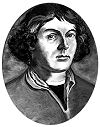 The first real serious and lasting theoretical challenge to the Ptolemaic system came from Nicolaus Copernicus (in his De revolutionibus orbium coelestium, On the Revolutions of the Heavenly Spheres) whose primary vocation lay in the areas of medicine, jurisprudence, math, administrator of a diocese and as the deputy counsellor on the financial regulations of Prussia (granted by the King of Poland). His earliest work in astronomy dates from 1500, during his visit to Rome, where he gave astronomical lectures while attending the jubilee. Image left of Nicolaus Copernicus courtesy the website 21st Century Masters - Copernicus [5]
Just when Copernicus began to think in terms of a sun-centered system is unknown, though it certainly occured after his visit and lectures to Rome in 1500; someone espousing such a radical theory as the heliocentric system would surely have ellicted comment, but there was none. The first record we have into Copernicus' thoughts in this direction are when Laurentius Corvinus assisted Copernicus (1508—09) in publishing his Latin translation of the Letters of the Byzantine Greek poet Theophylactus Simocatta by sending Copernicus's translation to the printer Johann Haller in Kraków. Corvinus, having read Copernicus' work, expressed admiration for his knowledge of astronomy and included two of his own poems within his work wherein he briefly refers to Copernicus' interest in astronomy, one of the earliest such historical records. What is certain is that in 1514, Copernicus wrote a six-page outline of his theory regarding a sun-centered solar system entitled Commentariolus (Little Commentary) and by 1533 this work had spread until it reached Rome where it was discussed at some length before an interested Pope Clement VII. In 1536 Copernicus received a letter from the Archbishop of Capua, Nicholas Schönberg, entreating him to present his concept of a sun-centered universe along with any associated research to him and his scholars. By 1539 his work had nearly reached its definitive form— the six-volumes of De revolutionibus orbium coelestium. [6]
Yet, Copernicus' road was a path that was both hesitant and cautious, likely due to the fear of persecution; he never fully accepted the favorable reception his work garnered nor the invitations sent him to openly present his theory. His work was published only at the time of his death, in 1543, and then by someone other than himself. Though it had been welcomed with great interest in his time, Copernicus' theory would not be substantially revived until an instructor of mathematics and astronomy at Tübingen, Michael Maestlin, began relating it in private—Maestlin had written a popular textbook which was a geocentric-based work and therefore, accorded with the current religious beliefs of the times—to a handful of select graduate students. For one young student, Copernicus' work would heavily influence the direction his own life's work would take. That student was Johannes Kepler.
The first real serious and lasting theoretical challenge to the Ptolemaic system came from Nicolaus Copernicus (in his De revolutionibus orbium coelestium, On the Revolutions of the Heavenly Spheres) whose primary vocation lay in the areas of medicine, jurisprudence, math, administrator of a diocese and as the deputy counsellor on the financial regulations of Prussia (granted by the King of Poland). His earliest work in astronomy dates from 1500, during his visit to Rome, where he gave astronomical lectures while attending the jubilee. Image left of Nicolaus Copernicus courtesy the website 21st Century Masters - Copernicus [5]
Just when Copernicus began to think in terms of a sun-centered system is unknown, though it certainly occured after his visit and lectures to Rome in 1500; someone espousing such a radical theory as the heliocentric system would surely have ellicted comment, but there was none. The first record we have into Copernicus' thoughts in this direction are when Laurentius Corvinus assisted Copernicus (1508—09) in publishing his Latin translation of the Letters of the Byzantine Greek poet Theophylactus Simocatta by sending Copernicus's translation to the printer Johann Haller in Kraków. Corvinus, having read Copernicus' work, expressed admiration for his knowledge of astronomy and included two of his own poems within his work wherein he briefly refers to Copernicus' interest in astronomy, one of the earliest such historical records. What is certain is that in 1514, Copernicus wrote a six-page outline of his theory regarding a sun-centered solar system entitled Commentariolus (Little Commentary) and by 1533 this work had spread until it reached Rome where it was discussed at some length before an interested Pope Clement VII. In 1536 Copernicus received a letter from the Archbishop of Capua, Nicholas Schönberg, entreating him to present his concept of a sun-centered universe along with any associated research to him and his scholars. By 1539 his work had nearly reached its definitive form— the six-volumes of De revolutionibus orbium coelestium. [6]
Yet, Copernicus' road was a path that was both hesitant and cautious, likely due to the fear of persecution; he never fully accepted the favorable reception his work garnered nor the invitations sent him to openly present his theory. His work was published only at the time of his death, in 1543, and then by someone other than himself. Though it had been welcomed with great interest in his time, Copernicus' theory would not be substantially revived until an instructor of mathematics and astronomy at Tübingen, Michael Maestlin, began relating it in private—Maestlin had written a popular textbook which was a geocentric-based work and therefore, accorded with the current religious beliefs of the times—to a handful of select graduate students. For one young student, Copernicus' work would heavily influence the direction his own life's work would take. That student was Johannes Kepler.
Maestlin to Brahe
I wanted to become a theologian, and for a long time I was restless. Now, however, observe how through my effort God is being celebrated in astronomy. — from a letter written by Kepler to Michael Maestlin [7]
Michael Maestlin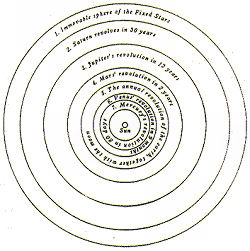 Copernicus wrote that the sun, not the earth, was at the center of the solar system, the six known planets moving in the firmament around the sun. In our present era, we know that the theoretical science underlaying Copernicus' theory was right; though he was well aware that his explanation was not completely correct. However, in many regions of 1594 Europe, to embrace such an idea could mark one suspect of heresy; to teach it as fact could end one's livelihood and to persist, one's life. Yet, for Tübingen's instructor of mathematics and one of Europe's most respected astronomers, Michael Maestlin, the theory made sense, enough so that in spite of the risks, he taught Copernicus' theory to a select "inner circle" of students of whom Kepler was one. The "private" sessions where Kepler heard of Copernicus' theory were wholly verbal for the six-volume publication De revolutionibus orbium coelestium was a forbidden text at Tübingen and Kepler would only read it years later. Nonetheless, Kepler embraced Copernicus' work with great enthusiasm and began to compile his own notes upon the subject which he felt made a great deal more sense than existing theories. Shown left is an image of Copernicus' model of a sun-centered solar system courtesy Nicholas Copernicus | Calendars. [8]
Wrote Kepler to a freind:
Copernicus wrote that the sun, not the earth, was at the center of the solar system, the six known planets moving in the firmament around the sun. In our present era, we know that the theoretical science underlaying Copernicus' theory was right; though he was well aware that his explanation was not completely correct. However, in many regions of 1594 Europe, to embrace such an idea could mark one suspect of heresy; to teach it as fact could end one's livelihood and to persist, one's life. Yet, for Tübingen's instructor of mathematics and one of Europe's most respected astronomers, Michael Maestlin, the theory made sense, enough so that in spite of the risks, he taught Copernicus' theory to a select "inner circle" of students of whom Kepler was one. The "private" sessions where Kepler heard of Copernicus' theory were wholly verbal for the six-volume publication De revolutionibus orbium coelestium was a forbidden text at Tübingen and Kepler would only read it years later. Nonetheless, Kepler embraced Copernicus' work with great enthusiasm and began to compile his own notes upon the subject which he felt made a great deal more sense than existing theories. Shown left is an image of Copernicus' model of a sun-centered solar system courtesy Nicholas Copernicus | Calendars. [8]
Wrote Kepler to a freind:Already in Tübingen when I followed attentively the instruction of the famous Michael Maestlin, I perceived how clumsy in many respects is the hitherto customary notion of the structure of the universe. Hence I was so very delighted by Copernicus, whom my teacher often mentioned in his lectures . . . [9]
Graz Calls for an InstructorThere is only one religion, though there are a hundred versions of it. — George Bernard Shaw, 1898 [10]
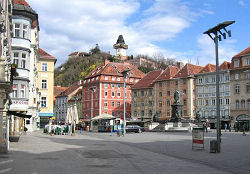 Kepler would doubtlessly have agreed with Shaw, for the more he studied the writings and teachings of his as well as other religions, the more he found himself frustrated and at odds with the proper way to worship God, until no one religion made sense. This aspect of Kepler's life would become important over the years as he began to bring the science of his theories towards his own style of worship; a union that would later bring him trouble. However, that was still in the future and for the moment, it was 1594 and a most important invitation was received at the university in Tübingen. Shown at left is an image of the Main square in Graz courtesy the TripAdvisor website.
Kepler would doubtlessly have agreed with Shaw, for the more he studied the writings and teachings of his as well as other religions, the more he found himself frustrated and at odds with the proper way to worship God, until no one religion made sense. This aspect of Kepler's life would become important over the years as he began to bring the science of his theories towards his own style of worship; a union that would later bring him trouble. However, that was still in the future and for the moment, it was 1594 and a most important invitation was received at the university in Tübingen. Shown at left is an image of the Main square in Graz courtesy the TripAdvisor website.The Protestant seminary in Graz (capital city in the Styria province of southeastern Austria) had just lost its instructor in mathematics and asked the university in Tübingen if they would recommend someone to replace him. In the early part of 1594 they did so by asking Johannes Kepler to fill the vacancy. Astonished and hesitant at first Kepler, now twenty-three years old, finally decided to accept the offer and so bidding farewell to Tübingen for what he believed to be no more than one or two years, headed for Graz, arriving there on April 11, 1594. Instead of the one or two years he had anticipated, Kepler spent the next six years at the seminary in Graz. Yet, he never felt truely at home there, even though his lectures in mathematics and astronomy, as well as lectures in other subjects, were good enough for his superiors to comment "that he was, considering his youth, a well-trained and modest master..." Oddly enough, Kepler's success and notoriety in Graz was not in the pure science of astronomy or math or even as an instructor but as a calender-maker and astrologist, a pursuit whose predictions he labelled as "monkeyshines", ridiculing those who read and believed in his forecasts of the future as "silly and empty" giving nourishment to nothing but "fatheads". Paradoxically, Kepler did believe in astrology in terms of the significance that the objects up in the heavens had in connection with the events of humanly endeavors on earth. [11]
Kepler believed in astrology in the sense that he was convinced that planetary configurations physically and really affected humans as well as the weather on earth. He strove to unravel how and why that was the case and tried to put astrology on a surer footing, which resulted in the On the more certain foundations of astrology (1601). In The Intervening Third Man, or a warning to theologians, physicians and philosophers (1610), posing as a third man between the two extreme positions for and against astrology, Kepler advocated that a definite relationship between heavenly phenomena and earthly events could be established. [12]
However, Kepler was no fool and there existed a more earthly and less ethereal reason for him to continue his astrology; as the business of his predictions continued with a very good record of accuracy, so too did the income they brought. So he continued making them and writing his calenders. However, Kepler never loss track of the passion that had now taken hold and therefore, kept his mind focused on his primary interests—the number and pattern of movements regarding the objects within the heavens above. Mysteries of the Universe Published, 1597I prefer a criticism even if sharp from a single intelligent man to the ill-considered approval of the great masses. — Letter written by Kepler to Galileo (1597) regarding Mysterium Cosmographicum [13]
In 1596 Kepler returned to his homeland in Swabia, finding that his fame had spread, having reached this area a year or so prior to his visit. In a granted two-months leave of absence from Graz (which actually lasted seven months) Kepler consulted with his friend and mentor Michael Maestlin who agreed with Kepler on the publishing of a book which would present his theories of the planetary orbits, based on his five Platonic solids which he had worked hard on while in Graz. Maestlin, impressed with the ingenuity of Kepler's ideas, agreed to oversee this work, editing the manuscript where needed and in the spring of 1597 the book, entitled Mysterium Cosmographicum or The Mystery of the Universe (shortened from its original 28 word Latin title) began publication from Tübingen.
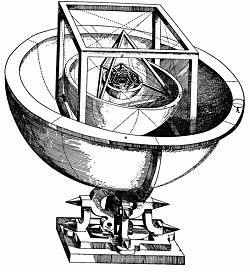
The strange notion which then dawned upon Kepler was the idea that the five Platonic solids, nesting one inside the other, could specify the relative distances of the six planets on their orbits round the sun. (He was by this time committed to the Copernican, sun-centred universe.) Only one person had astronomical observations accurate enough to test this model, and that was Tycho Brahe; and, to quote Sagan again, "by chance, at Rudolf's suggestion, he [that is Brahe] had just invited Kepler, whose mathematical fame was growing, to join him in Prague". This belief meant a lot to him, even though his later discovery of elliptical orbits was somewhat to diminish its credibility. Shown at left is a diagram from Mysterium Cosmographicum showing the five Euclidean solids as planetary orbits, from Wikimedia Commons. [14]
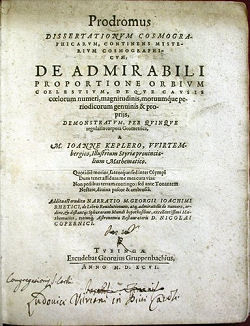 Yet, the greatest influence his book had came not from within its pages but from without, as Kepler had sent copies of it to the two individuals whose influence upon the scientific world of astronomy were to first, give it both unprecendented accuracy and second, shake the very foundations of its nearly 1800 year belief in how the universe worked: the German astronomer Tycho Brahe and the Italian Florentine, Galileo Galilei. Eager to seek the opinions of the scientific and scholarly world, Kepler wrote and asked both Galileo and Tycho, amonst others, for an opinion of his work. Ironically, Galileo remained silent, though Kepler discovered several years later that Galileo made use of some of the book's content in his own lectures (such was Galileo's character as we shall later discover). Tycho on the other hand responded, cautious and respectful in his criticism while at the same time, noting the genius of the young Kepler's work. More importantly, Tycho let it be known that if Kepler cared to come to him, he could attain an assistantship. Of this period Kepler wrote, "the direction of my whole life, my studies and work, took its departure from this one booklet." Image right is the title page of Kepler's book Mysterium cosmographicum and is courtesy the History of Science University of Oklahoma Libraries [15]
Yet, the greatest influence his book had came not from within its pages but from without, as Kepler had sent copies of it to the two individuals whose influence upon the scientific world of astronomy were to first, give it both unprecendented accuracy and second, shake the very foundations of its nearly 1800 year belief in how the universe worked: the German astronomer Tycho Brahe and the Italian Florentine, Galileo Galilei. Eager to seek the opinions of the scientific and scholarly world, Kepler wrote and asked both Galileo and Tycho, amonst others, for an opinion of his work. Ironically, Galileo remained silent, though Kepler discovered several years later that Galileo made use of some of the book's content in his own lectures (such was Galileo's character as we shall later discover). Tycho on the other hand responded, cautious and respectful in his criticism while at the same time, noting the genius of the young Kepler's work. More importantly, Tycho let it be known that if Kepler cared to come to him, he could attain an assistantship. Of this period Kepler wrote, "the direction of my whole life, my studies and work, took its departure from this one booklet." Image right is the title page of Kepler's book Mysterium cosmographicum and is courtesy the History of Science University of Oklahoma Libraries [15]
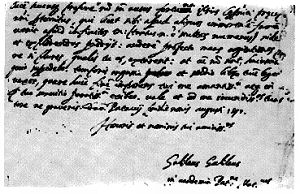 "Two copies [of Cosmographicum] were brought to Italy by Kepler's friend Paul Hamberger and both were left with Galileo, at Padua, on the eve of Hamberger's return to Germany. He carried a note of thanks to Kepler from Galileo, dated August 4, 1597. Kepler wrote back urging Galileo to support publicly the Copernican theory, asking him to carry out some measurements and to seek his opinion of the book." Shown at left is Galileo's thank you note to Kepler for having sent him a copy of Mysterium cosmographicum. Kepler again wrote Galileo, this time asking him to support publicly the Copernican theory as well as asking him to carry out some measurements; however, Galileo did not reply. [16]
"Two copies [of Cosmographicum] were brought to Italy by Kepler's friend Paul Hamberger and both were left with Galileo, at Padua, on the eve of Hamberger's return to Germany. He carried a note of thanks to Kepler from Galileo, dated August 4, 1597. Kepler wrote back urging Galileo to support publicly the Copernican theory, asking him to carry out some measurements and to seek his opinion of the book." Shown at left is Galileo's thank you note to Kepler for having sent him a copy of Mysterium cosmographicum. Kepler again wrote Galileo, this time asking him to support publicly the Copernican theory as well as asking him to carry out some measurements; however, Galileo did not reply. [16]-fn2
Closing of the 16th Century, 1597—1600
It was not just the Church that resisted the heliocentrism of Copernicus. — Tycho Brahe
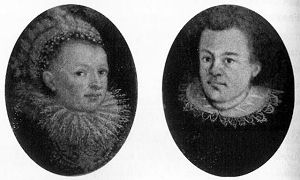 Events over the next three years would set the stage for the high and low points of Kepler's life, much of it a result of the turbulent religious strife prevalent during the period in which he lived. In the later part of 1595, Kepler had met and fell in love with Barbara Müller, daughter of a wealthy merchant who had already twice married. Kepler ask for her hand early on (January of 1596), but it would be almost eighteen months before he would finally be able to marry her, their wedding not taking place until April 27, 1597. Though Kepler was obviously pleased with the union, events began to unfold that would tax his spirits: in 1598 and 1599 respectively, Barbara would give birth first to a boy and then a girl, both of whom did not survive infancy due to spinal meningitis. His marriage, as was the custom of the period, was as much for love as it was for the material benefits that Barbara's wealthy family might bring, but these were not forthcoming as Kepler was later to admit. Seen at right are the portraits of Kepler and his wife in oval medallions, from Wikipedia. Original paintings are oil on copper, 7 cm x 5 cm. Scanned from Kepler's Witch by James A. Connor.
In the meantime, even more ominous storm clouds appeared on the horizion when, in 1596, Archduke Ferdinand came to power in Styria. An ardent catholic, Ferdinand went about cleaning house by ridding Styria of its Prostestant teachers and theologians under a final edict in 1598 that gave them eight days to leave or be put to death. On the eight day they did so, moving out of the area, Kepler included. They waited for word that they could return to the region but that was not forthcoming save for one; in less than a month's time Johannes Kepler was allowed to return to Styria, but he was well aware of the fact that his days at Graz were numbered, having already written to a friend that neither he nor his wife looked forward to leaving Styria.
Events over the next three years would set the stage for the high and low points of Kepler's life, much of it a result of the turbulent religious strife prevalent during the period in which he lived. In the later part of 1595, Kepler had met and fell in love with Barbara Müller, daughter of a wealthy merchant who had already twice married. Kepler ask for her hand early on (January of 1596), but it would be almost eighteen months before he would finally be able to marry her, their wedding not taking place until April 27, 1597. Though Kepler was obviously pleased with the union, events began to unfold that would tax his spirits: in 1598 and 1599 respectively, Barbara would give birth first to a boy and then a girl, both of whom did not survive infancy due to spinal meningitis. His marriage, as was the custom of the period, was as much for love as it was for the material benefits that Barbara's wealthy family might bring, but these were not forthcoming as Kepler was later to admit. Seen at right are the portraits of Kepler and his wife in oval medallions, from Wikipedia. Original paintings are oil on copper, 7 cm x 5 cm. Scanned from Kepler's Witch by James A. Connor.
In the meantime, even more ominous storm clouds appeared on the horizion when, in 1596, Archduke Ferdinand came to power in Styria. An ardent catholic, Ferdinand went about cleaning house by ridding Styria of its Prostestant teachers and theologians under a final edict in 1598 that gave them eight days to leave or be put to death. On the eight day they did so, moving out of the area, Kepler included. They waited for word that they could return to the region but that was not forthcoming save for one; in less than a month's time Johannes Kepler was allowed to return to Styria, but he was well aware of the fact that his days at Graz were numbered, having already written to a friend that neither he nor his wife looked forward to leaving Styria.
In addition, all children were now forced to attend Jesuit schools only. At the Stiftschule where Kepler taught, Catholic clergy were substituted for the banished Protestant ministers. All books thought to be against Catholic doctrine were collected and destroyed...Convinced during these harsh months that time was running out for him in Graz, Kepler became seriously concerned about the future. Where would he go? What would he do? To return to Wurttemberg and become a Lutheran clergyman was out of the question for him now, for his personal religious beliefs no longer coincided with those of strict Lutheranism. [17]
With the stage now set, the year 1600 exploded onto the historical scene as numerous riots began breaking out all over the region, tensions running at their highest point. Then, in the summer of that year, the Counter Reformation again reared its ugly head; luckily for science that year also marked an event that would forever change the face of astronomy, the meeting of Johannes Kepler and Tycho Brahe.
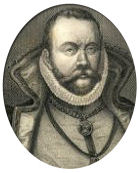 Thus on February 4, 1600, Kepler, carrying a note of high recommendation written by Hoffman, rode northward toward Benatky Castle in the company of one of Tycho's sons.
Thus on February 4, 1600, Kepler, carrying a note of high recommendation written by Hoffman, rode northward toward Benatky Castle in the company of one of Tycho's sons.
Brahe greeted Kepler warmly and hospitably, for he was genuinely pleased to have the young man with him at last. Each exerted the utmost of his charm which in both cases could be considerable. On that long afternoon of ardent talk and touring about the castle, each of the two men was feeling the other out. Each expected a great deal of the other. Indeed, in spite of their contrasting ages and circumstances, Tycho Brahe and Johannes Kepler needed each other badly. Shown at left is a portriat of Tycho Brahe. [18]
Before venturing further, let us now look to the individual who, at this time, was regarded as the foremost astronomer in Europe, indeed, in the entire world—Tycho Brahe. Next — Page 5
Footnotes
1. There were of course, other reasons behind the retention of the geocentric model outside the bounds of "logical reasoning". It should be pointed out that by the 16th century, religion had embraced and expanded upon the earlier works regarding an earth-centered system. The Apollonian Model particularly shows the Earth at the center of the universe with a band of stars all around. Inside the misnamed "solar" system all the planets orbit the sun and the moon and the stars orbit the Earth. In addition, the church was able to read the proof of this geocentric system (that the earth is fixed and immovable and lies at the center of all things) from within the pages of the Bible itself. This was a scriptural based concept and the most important biblical quote supporting it was found in the Book of Joshua, 10:12-13, wherein the Amorites are defeated as a result of the miracle of Joshua (also referenced in the book of Habakkuk, 3:11). In 1 Chronicles 16:30 the Earth is shown to remain unmovable: tremble before him, all earth; yea, the world stands firm, never to be moved. Further references that gave theologians proof of earth's imobility are found in Psalms 93:1 and Psalms 96:10. See: Glenn Elert's The Scriptural Basis for a Geocentric Cosmology for an interesting look into this aspect of science and religion, © 1992-2008.
2. Galileo's silence to Kepler's second letter has been attibuted to his non-involvement within astronomy at this time, Galileo did not reply, possibly because he was not yet fully interested in astronomy. See: BRIEF BIOGRAPHY OF JOHANNES KEPLER. However, author D. C. Knight, in Johannes Kepler And Planetary Motion, p.36 (see [8] below) says But Galileo, who could be testy and difficult even jealous at times remained silent. What is important at this juncture is that Galileo's first letter to Kepler contains the statement that he (Galileo) has supported Copernicus' theory for some years. See: the Galileo Timeline at Rice University, which places the beginning of his support for Copernicus' theory in circa 1595.
Chapter Three
Dangerous Concept, Dangerous Times: Galileo, Kepler and the Church
Present & Future Historical Bytes











© Legal Copyright Notice:
Unless otherwise stated, all images, screen shots, electronic materials including instructional, software, scripts and web pages referred to herein or incorporated by reference are copyrighted © by A Universe in Time. None of the content herein may be reproduced or copied in any manner from this website without the prior written permission of above indicated copyright holder(s). All images and orginal works of the author(s) used within the above or foregoing web pages are for the sole purpose of information and display at A Universe in Time website and have been used with the kind permission of the respective owner(s).
BACK TO THE TOP

